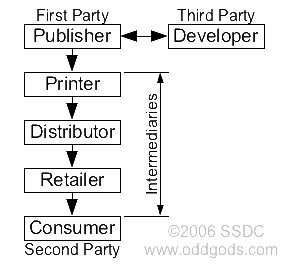
 |
Syncopated Systems™
Seriously Sound Science™
|
| Home | About | Library | Contact |
How the Computer Game Industry WorksThis article describes businesses within the computer game industry. For a description of generally-accepted business management practices for all industries, see An Introduction to Business. The first step toward understanding the computer game industry is understanding where games come from. To do this, one should first understand the commerce and consumption of video and computer games, and the parties involved therein. Commercial NomenclatureModern video and computer games are typically played on video game consoles or personal computers that have no built-in game program, allowing and requiring the player to purchase the games and game systems seperately. Transactions Consumers purchase game systems from manufacturers, usually through intermediaries such as distributors and retailers. In seperate transactions, though usually at the same time, consumers purchase games from publishers, also usually through intermediaries such as distributors and retailers. The games themselves – specifically, the "content" that is reproduced by publishers – is created by developers. Parties InvolvedUsing legal terminology to describe the parties in transactions, consumers purchasing games are the second parties; publishers and developers are either first parties or third parties. PublishersA publisher that also makes the game system (or platform) that the game will run on is always referred to as a first-party publisher; examples include Atari, Nintendo, Sony and Microsoft. Other publishers are sometimes referred to as third parties, but this is technically only correct when describing the transaction in which the consumer purchases the game system; for transactions in which the consumer purchases a game from one of these publishers, even if purchasing through intermediaries such as distributors and retail stores, the publisher is technically the first party. DevelopersPublishers may develop games "in-house" through internal development departments or subsidiaries, or outsource game development to third-party developers. Publishing a GamePublishing a game is very much like publishing a book or a magazine. A publisher usually offers a game for either a one-time fee (a non-recurring charge, like that for a book) or a recurring charge, like a magazine subscription. Usually, the concept for a game comes from a publisher, which also secures the necessary licenses (such as N.F.L., N.B.A., movie titles, etc.). With a concept for a game, a publisher then seeks a developer; over time, the two develop a product specification, project budget and development schedule. If mutual agreement can be reached, development of the game begins. The developer then works like the writer of a manuscript, often submitting several revisions to show progress (at project milestones) and to correct defects. After the publisher receives, reviews, and approves a master copy from the developer, it then releases this final "gold" master for replication, often called "pressing". Once pressed and packaged, these copies of the game are often sold to distributors and then to retailers. Publishers may circumvent these intermediaries by selling games directly to consumers; Internet connectivity allows direct sales of games, and may also be appropriate for delivering games such as some multiplayer online games (MOGs), which already require consumers to have Internet access to play.
Developing a GameThough publishing a game is similar to publishing printed media, developing a game more closely resembles directing a theatrical play or a cinematic motion picture. Imagine a play with marionettes (stringed puppet figures). Game designers provide the overall concept of the script, direct the action, and often write dialog. The figures are made by three-dimensional model makers, their skins and clothes are painted by two-dimensional artists, the mechanisms for movement (the handles and strings) are provided by computer programmers, and the characters are brought to life by animators who choreograph their movements. Model makers and artists create the sets. Actors record their voices and sometimes also their movement to aid the choreographers. Musicians and sound designers provide musical scores and sound effects. Before its public availability, the production is usually rehearsed and tried before several initial audiences of play testers. When the capacity of game media was still very small, necessitating much simpler games (see the media capacity chart), a game was often created by only one person. Nowadays, though popular games are still sometimes created by only one or two people, developing a sophisticated game usually requires roughly 50 people working for about two years, with project development budgets of several millions of dollars. As games and their budgets grew, so did the need for financial and project managers; as with theatrical or cinematic productions, these people are often called producers. Related ReadingFor a description of generally-accepted business management practices for all industries, see An Introduction to Business. For further reading on the history of video and computer games and their technology, see the introduction to Electronic Game Industry History and Historical Trends Defining Generations of Electronic Games, which introduces the Electronic Game Industry Timeline. The Historical Size Constraints in Electronic Games provides an illustrated summary of growth in media size constraints affecting video and computer games. |